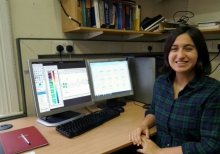
University:
Major:
Site Abroad:
Mentor(s):
Faculty Sponsor(s):
Faculty Sponsor's Department:
Project Title:
Project Description:
Graphene nanoribbons (GNRs), unlike extended graphene sheets, are found to have width-dependent electronic band gaps which can be tuned to lie within a useful range for various electronic applications such as transistors and solar cells. In recent years, novel bottom-up methods of synthesis have allowed for greater control and creativity in GNR fabrication: in choosing a metal substrate and specific starting molecules, one essentially chooses which types of GNRs can be made. In this project, density functional theory (DFT) calculations were used to predict the electronic bandstructure of varying armchair-type GNRs (AGNRs) for future comparison with experimental results arising from Angle Resolved PhotoEmission Spectroscopy (ARPES). In AGNRs of widths 6, 9, 12, 15, and 18 carbons across, hybrid functionals were used to calculate the gap between the highest occupied and lowest unoccupied molecular orbitals, as well as the band dispersion. Additionally, 7-AGNRs – that is, AGNRs which have 7 parallel rows of carbons – and 7-AGNRs incorporating differing organometallic molecules into their ribbon structure were compared according to their calculated energies, densities of states, and molecular orbital geometries near the Fermi level. The configuration of substituent groups transverse to the repeating ribbon direction was examined more closely to determine the lowest energy structure and the aromaticity of several possible structures. These theoretical studies of both 3n-AGNRs and organometallic-incorporated 7-AGNRs have led to greater understanding of both types of systems and will be useful when compared to the existing experimental data.
